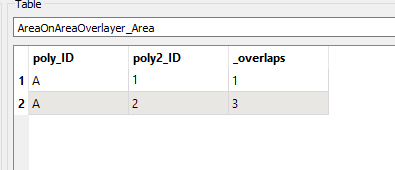Hello,
I'm intersecting two layers of data (polygon.shp and plygon2.shp). One of them (polygon2.shp) has two completely overlapping polygons. I'm getting this:

How to get this:

Here is the sample data: .
Hello,
I'm intersecting two layers of data (polygon.shp and plygon2.shp). One of them (polygon2.shp) has two completely overlapping polygons. I'm getting this:

How to get this:

Here is the sample data: .
Best answer by ebygomm
Do you actually want to intersect the polygons or just find the overlaps?
At the moment the polygons A,1&2 are sent into the area on area overlayer. One area is returned which is the area of polygon A which does not overlap any other polygon. The other area that is returned is the area of polygon A which overlaps both polygon 1 &2 (hence why overlaps says 3)
This is the shape returned where the poly2_ID is missing, it is the area that is not overlapped by any other polygon

If you are just looking for a report of which poly2_IDs overlap poly_ID A then I'd suggest a spatial relator set to intersect, build a list then list explode.